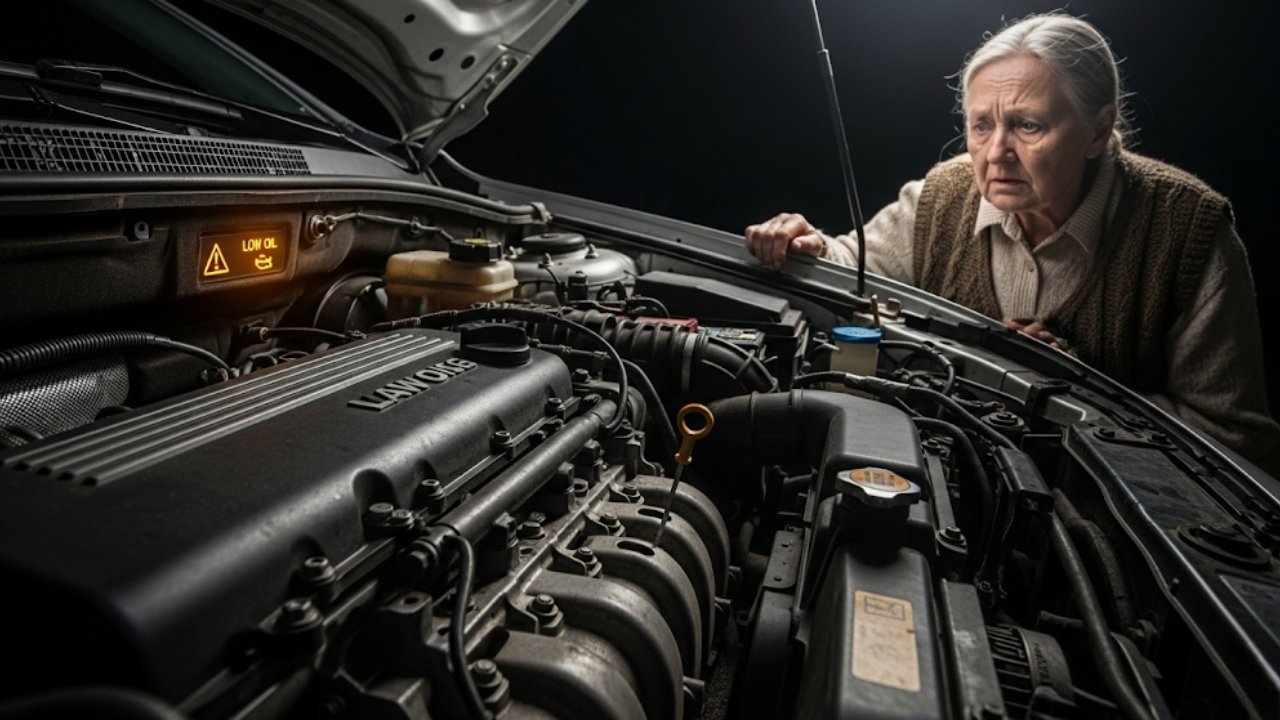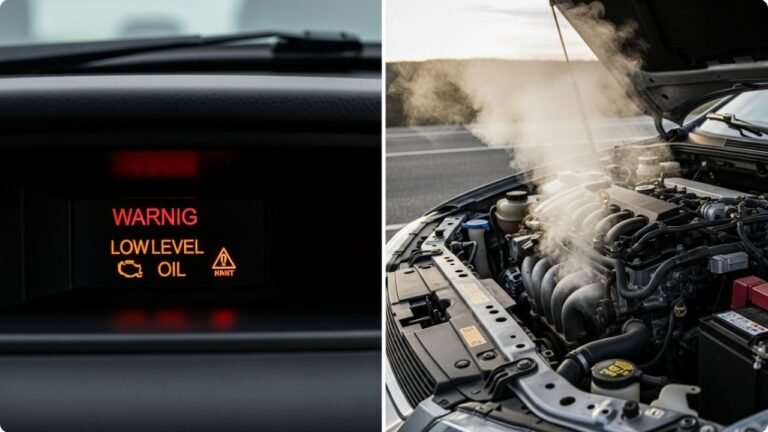No Oil in the Car: A Costly Mistake You’ll Regret

I still remember that morning vividly.
The sky was golden, birds were chirping, and I was already late for work. I grabbed my keys, tossed my bag in the passenger seat, and turned the ignition. The engine made a strange clicking sound—but started anyway. I shrugged it off.
Big mistake.
About ten minutes into the drive, my car began to whine. Then it coughed. Then… it just died.
That’s when I found out there was no oil in the car.
That one mistake taught me more than any manual ever could. In this article, I want to walk you through what really happens when you run a car with no oil, how to spot the signs before it’s too late, and most importantly—how to avoid repeating my painful (and expensive) mistake.
Let’s dive in.
Why Engine Oil Is the Lifeblood of Your Car

Oil doesn’t just “sit” inside the engine. It actively lubricates, cools, cleans, and protects. Without it, your engine’s parts—many of which move at high speeds—begin to grind against each other, creating heat, friction, and eventually, irreversible damage.
Here’s what engine oil actually does:
-
Reduces friction between engine parts
-
Prevents overheating by dissipating heat
-
Cleans sludge, metal particles, and carbon buildup
-
Seals gaps between piston rings and cylinder walls
-
Extends the life of the engine
So when there’s no oil in the car, it’s like asking your heart to pump without blood. It just doesn’t work.
How I Missed the Obvious Signs of No Oil in the Car
I should’ve known. I had seen the signs—but ignored them.
Let me break down the most common warning signs that there’s no oil in the car, so you can avoid what I went through.
Signs You Might Be Driving With No Oil in the Car
-
Oil Warning Light: This glows red or orange. Never ignore it.
-
Knocking or Tapping Noises: Dry parts start colliding.
-
Burning Smell: Without oil, metal heats up and burns.
-
Overheating Engine: Lack of lubrication means the engine works harder.
-
Stalling or Complete Engine Shutdown: That’s the endgame.
If you experience even one of these, stop driving immediately. I didn’t—and I paid the price.
What Happens to the Engine When There’s No Oil?
You know that awkward sound of metal scraping metal? That’s your engine crying for help.
Here’s what really goes on under the hood when there’s no oil in the car:
| Time Without Oil | What Happens to Your Engine |
|---|---|
| 0–5 minutes | Increased heat and friction |
| 5–15 minutes | Parts begin warping or seizing |
| 15+ minutes | Full engine failure likely |
Without oil, your engine becomes a giant furnace. Pistons seize. Valves break. Bearings wear down. And within minutes, your entire engine can lock up—sometimes beyond repair.
Trust me, towing your car off the side of the highway and hearing a mechanic say “your engine is toast” is a gut-punch you’ll never forget.
The True Cost of Running With No Oil in the Car
When I first heard the damage cost, I genuinely thought the mechanic was joking.
He wasn’t.
The reality is, repairing engine damage from no oil is one of the most expensive car mistakes you can make. Depending on the severity, you’re looking at:
-
$3,000 – $6,000 for an engine rebuild
-
$5,000 – $10,000+ for a full engine replacement
-
$100+ just to tow the car to the shop
-
Time lost from your routine or job
Let me be real—it’s not just the money. It’s the stress. The missed work. The late-night Googling for second-hand engines. All because I overlooked no oil in the car.
If you’re ever unsure, check your oil. It’s free and takes less than 5 minutes.
How to Check Oil: The 2-Minute Trick Everyone Should Know
Checking your oil should be as routine as brushing your teeth. Yet so many people skip it.
Here’s how to do it the right way:
✅ Step-by-Step: How to Check Your Car’s Engine Oil
-
Park on a level surface and turn off the engine.
-
Let the engine cool for 5–10 minutes.
-
Pop the hood and find the dipstick (usually yellow or orange).
-
Pull it out and wipe it clean.
-
Reinsert fully, then pull it out again.
-
Check the oil level and color:
-
If it’s between MIN and MAX, you’re good.
-
If it’s low or empty, add oil immediately.
-
Tip: Clean oil is amber and slightly transparent. Dark, thick oil means it’s time for a change.
If I had done this weekly, I would have caught the problem before there was no oil in the car.
Why Oil Disappears (Even If You Didn’t Notice)
Here’s a wild fact: Your engine can lose oil without leaking.
It may sound strange, but internal oil consumption is a thing. And it can sneak up on you.
Common Reasons for Losing Oil:
-
Burning oil due to worn-out piston rings or valves
-
Old gaskets causing slow leaks
-
High-mileage engines naturally consume more oil
-
Cheap or wrong oil type breaking down faster
That means you can have no oil in the car, even if your garage floor looks perfectly clean.
How Often Should You Check or Refill Engine Oil?
Short answer? Every two weeks or 1,000 kilometers, whichever comes first.
Long answer? It depends on your car’s age, how often you drive, and the type of oil you use.
General Guidelines:
| Car Type | Check Frequency | Oil Change Interval |
|---|---|---|
| Newer (<5 years) | Every 2-3 weeks | 5,000–10,000 km |
| Older (>5 years) | Weekly | 3,000–5,000 km |
| High-performance | Weekly or before trips | 3,000–7,000 km |
The goal? Never be in a situation where there’s no oil in the car—because by the time you notice, it’s often too late.
How I Felt After Destroying My Engine
Let’s get real for a second.
When I found out the damage, I didn’t just feel stupid. I felt defeated.
That car had memories. Road trips. First dates. Late-night food runs. All of it—gone. Because I skipped a 2-minute check.
I couldn’t help but think: How many others are making the same mistake?
That’s why I’m writing this. So you don’t have to go through what I did.
What to Do Immediately If There’s No Oil in the Car
So you’ve realized there’s no oil in the car—what now?
Don’t panic. But don’t delay either.
Here’s your emergency playbook:
Step-by-Step Actions to Take Right Now
-
Turn off the engine immediately.
Even one more minute can cause damage. -
Let the engine cool down.
Wait at least 30 minutes. Don’t touch anything hot. -
Check the dipstick.
Confirm the oil level. If bone dry, that’s your red flag. -
Add engine oil if you have it.
Use the correct type listed in your manual. -
Do NOT restart the engine yet.
Wait after adding oil. Then turn the key gently. -
Listen for unusual noises.
Clicking or knocking = call for a tow. -
Visit a mechanic as soon as possible.
Even if your car seems okay, internal damage could be hiding.
These steps saved a friend of mine from needing a full engine replacement. A $25 bottle of oil beat a $4,000 rebuild.
Long-Term Damage from No Oil: What to Watch For
Even after adding oil, you might not be out of the woods.
Driving with no oil in the car, even for a short time, can cause hidden damage that worsens over weeks or months.
Common Long-Term Symptoms to Watch
-
Loss of engine power: Struggles on hills or acceleration
-
Knocking or rattling sounds: Persistent, rhythmic tapping
-
Increased oil consumption: Oil disappears quickly
-
Excess smoke from exhaust: Especially blue or gray smoke
-
Rough idling or stalling: Vibrations or shaking when stopped
If you spot any of these, don’t brush them off. A mechanic can check for worn-out pistons, broken gaskets, or oil pump failure—all caused by past oil starvation.
❌ Myths About Oil That Could Ruin Your Engine
There’s a lot of bad advice floating around. Let’s bust some myths before they cost you.
️ Common Oil Myths Debunked
-
“Oil doesn’t go bad.”
It does. Over time, it breaks down and loses effectiveness. -
“I don’t see leaks, so oil’s fine.”
Internal burning doesn’t leave puddles. -
“Thicker oil lasts longer.”
Not always. Wrong viscosity can damage your engine. -
“Electric cars don’t need oil.”
Fully electric, no. Hybrids? Some still do. -
“I changed it last year, it’s good.”
Oil should be checked regularly, not just yearly.
Believing these myths is a shortcut to ending up with no oil in the car—and a world of mechanical regret.
️ How to Prevent Future Oil Trouble (The Smart Way)
The best fix is prevention. And it doesn’t take a degree in mechanics to keep your engine safe.
Smart Habits to Avoid Oil Problems
-
Check your oil twice a month.
Build the habit into your routine. -
Use high-quality oil.
Don’t go cheap. Your engine’s health depends on it. -
Change oil filters regularly.
Dirty filters block flow, starving your engine. -
Keep an eye on dashboard lights.
Don’t wait until you hear noises. -
Log oil changes in your phone.
Simple reminders help avoid accidental neglect. -
Watch for smell and smoke.
Your nose and eyes are great warning systems.
These small habits saved my second car from meeting the same fate as the first.
❓ FAQs: No Oil in the Car
Let’s clear up some quick questions people often ask after that scary “oil light on” moment.
1. Can I drive my car with no oil for a few minutes?
No! Even a few minutes without oil can start damaging critical parts like pistons and bearings. Pull over as soon as it’s safe.
2. Why didn’t my oil warning light come on before the engine died?
The oil pressure light only turns on after pressure drops—which can be after damage has already begun. It’s not an early alert system.
3. How often should I add or top off oil?
Only when the dipstick shows low oil. If you’re topping up often, your car may have a leak or burning oil issue.
4. Can I use any motor oil in an emergency?
In a pinch, yes—but make sure it’s the right viscosity (e.g., 5W-30). Don’t mix synthetic with conventional unless you’re stranded.
5. What should I do if oil keeps disappearing?
You may have a slow leak or internal burn. Get your engine inspected. Constant oil loss isn’t normal.
6. How do I know the right oil type for my car?
Check your owner’s manual, or look online by entering your car’s make and model. Always double-check the viscosity and oil grade.
7. Can I repair engine damage from no oil?
Sometimes. If you act fast, flushing the system and replacing worn parts may help. But full engine rebuilds or replacements are often needed.
8. Is synthetic oil better than regular oil?
Yes, generally. Synthetic oil lasts longer, flows better at low temps, and protects better at high temps. But it’s more expensive.
Final Thoughts: My Mistake, Your Lesson
Driving with no oil in the car was a hard lesson I’ll never forget.
But maybe, just maybe, you won’t have to learn it the hard way.
Cars are complicated. Life gets busy. But two minutes of checking oil can save thousands of dollars and untold stress. Whether you’re a new driver, a busy parent, or someone like me who just got too comfortable—it’s never too late to start taking better care of your engine.
Your car’s health is in your hands. Literally, on that dipstick.
So take a breath, pop the hood, and check that oil. Today.






